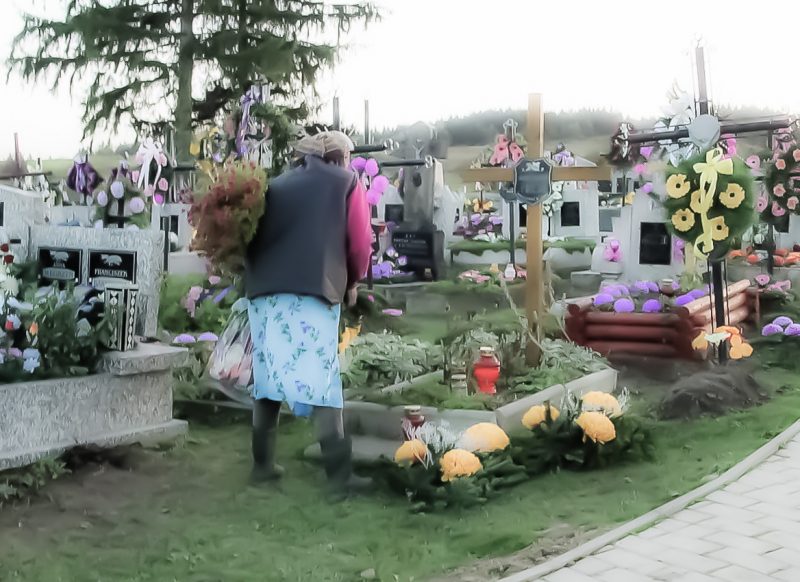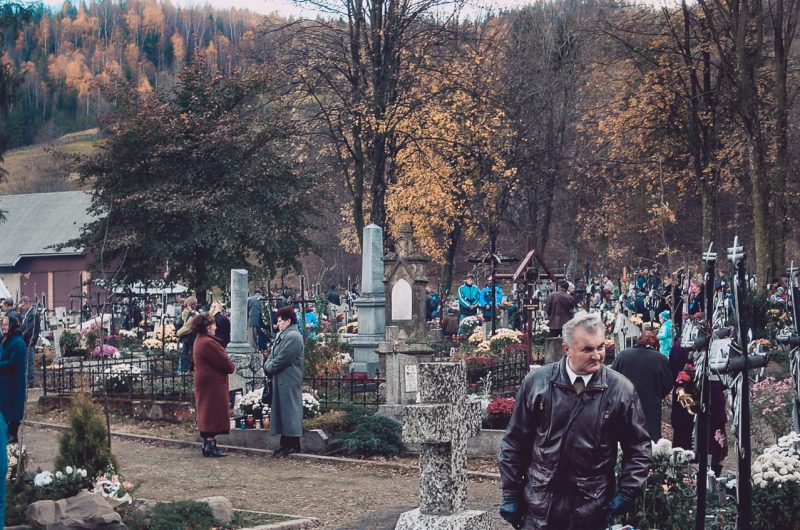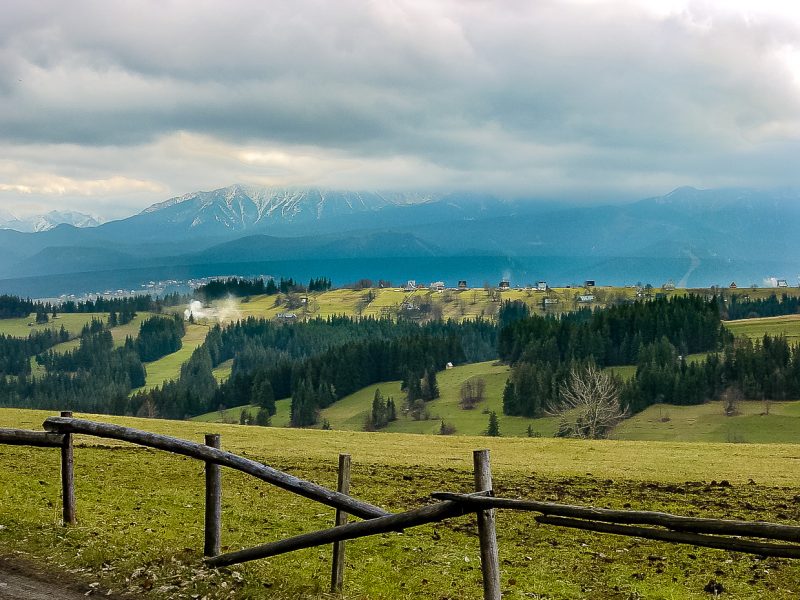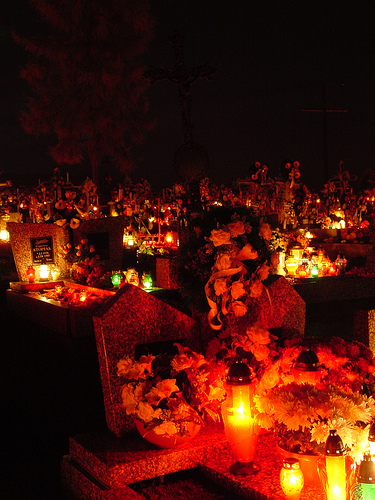A few pictures from twenty years ago, re-edited.




A few pictures from twenty years ago, re-edited.




Today is All Saints’ Day — one of the best times to be in a Catholic country like Poland. This morning, every single cemetery in Poland had something like this going on.

Every year I write the same things and probably show some of the same pictures. Since we haven’t experienced All Saints’ Day in Poland since 2004 (has it really been that long?), I’ve only a very limited stock of photos, and an even more limited stock of stories: I can only tell the same stories so many times before even I get tired of them.
That’s something of the appeal of it: the repeating ritual of the Catholic liturgical calendar means we’re always coming back to the same place. It makes life less of a straight line and more of a spiral.
One of the most calming and consoling times in that spiral is the evening of All Saints’ Day, when all the cemeteries flicker with the light of thousands of candles, and the hissing, crackling, and popping of the candles punctuate the prayers of the faithful.

I would visit the cemetery at least twice: once when the priests were leading prayers and a second time when no one else was there. Both were calming in very different ways.
Surrounded by Poles who had intimate connections to the cemetery — here lies a brother, a mother, an uncle, a great-grandmother — I felt the peace of the community, even though I was an outsider. Catholicism is very communal and intimate, and prayers in a candle-light cemetery are the epitome of that intimacy and community spirit.
Yet it was when I was alone that I felt more calm than I’ve ever felt in my life. Surrounded by death, I felt more alive than any other time of the year.
Halloween, in comparison, is so distinctly American: commercial, whimsical, with just enough evil to make us worry but not enough to make us act.
I prefer the Polish Catholic version, and I would imagine I always will.
5:17 p.m.
I left my apartment around 4:30 and headed up to the cemetery to witness my first All Saints’ Day in Poland. I weaved my way through the maze of mud puddles that serve as my front yard and made it to the road, and suddenly it was if I was in Kraków instead of Lipnica. The street was filled with people, all leaving the cemetery as I made my way to the cemetery. I felt like the one Israelite who might have decided to turn back in the middle of the exodus. With my camera in hand and a bewildered look plastered across my face, I surely looked like a fool. But I didn’t care, for I was about to experience something I had heard about since arriving in Poland.
I made it to the graveyard and began wandering among the markers, making mental notes of all I saw. I watched families finish making a grave just so, arranging flowers and candles, speaking in whispers, then stand up, cross themselves, and walk away. I saw solitary babcias roaming about, their heads covered with the customary babcia scarf. They stopped in front of graves, hands laced together in front of them, their lips dancing as they muttered a prayer.
As I wandered about the hilltop cemetery, I was struck by a number of isolated, seemingly unconnected events. I saw a beautiful woman standing by a marker, not moving a muscle. I glanced at the grave: it indicated that the deceased died young, and only a couple of years ago. I looked at the woman’s face again and saw the immediate pain of a sudden, unexpected loss still in her eyes. It appeared that she still had not come to accept the death.
I walked on but stopped immediately when I saw a tombstone that haunted me: born, 1973. This girl was born only a few months after me, yet died years ago, I though. I shivered a bit. Maybe it was the wind; perhaps it was that I sensed my own mortality.
In one portion of the cemetery I noticed exceptionally small graves. Children, I realized as I approached. I walked among graves of infants and small children, and saw markers for children whose life was a single day. I tried to imagine what it must be like to lose a child. It certainly is something that is beyond all comprehension, for I could not begin to imagine having a child, let alone losing it.
Since I knew none of the names on the graves, I simply cast my eyes from one to another, looking more at the marker itself than anything: I saw many types in various states. Some were elaborate and ornate. Others were plain metal crosses. And I saw one simple cross of rough wood with no name. Some of the graves had settled unevenly and as a result one corner dipped farther into the earth.
And while all these observations seem only somewhat connected, I realize now that instead they all share in an intimate relationship. Just as all the people on that windy hilltop are acquainted with each other in various degrees (from intimate friends to total strangers), the people resting under the iron crosses and stone markers are acquainted with each other through the passing of life. It is life that brought everyone, whether no living or dead, together on this night, and all my various little observations were sewn into life.
One might imagine that standing in the midst of so much death would be depressing and upsetting. Instead, with the sound of hissing and popping candles and the people quietly paying their respects, it was astoundingly and beautifully peaceful. Regardless of my own doubts about God’s existence, it was a profoundly spiritual experience.
When I first got there I wanted to pull out my camera and immediately begin snapping pictures. Yet there was a sacred and profound peace enveloping everything, and I felt it would be decidedly inappropriate to turn people’s quiet moment of communion with the past into a photo opp for me.
Still, when I found myself sufficiently secluded, I would take a shot or two. As the sun set and the sky darkened, it became easier to move about inconspicuously (and the hilltop became more beautiful), so I took more and more photos.
More impressions: There were many graves for two people, obviously a husband and a wife. And there were quite a few of these that were occupied by only one person. How must that feel to visit the grave of your husband or wife and see beside it the space reserved for you? “If these people wanted,” I mused, “They could come and dance on their own graves.”
The ground was muddy and stuck in clumps to my shoes. I literally took part of the experience home with me.
It was amazing how much light a thousand candles can put off. The hill glowed and the two trees in the center of the cemetery reflected the light. I remember that the intensity of a light is measured in something called candlepower. This was true candle power.
I understand what my parents used to say when we went to funerals: “It’s not for the dead, but for the living.” Such is the case for graveyards, too. Being surrounded as I was by death, I was reminded that though I too will eventually die, right now I am alive. Right now I can still feel the wind and cold drizzle and worry about the candles’ safety in such elements. Right no I can slosh around in the mud, wandering among the graves. Right now I can feel the heat put off by so many candles. So this must by why (at least partially) we fence off areas of the earth to put the bodies of friends and family into the ground and mark the spot with a bit of granite, wood, or iron.
It is also a link to one’s own past. That is part of the reason I felt like such a tourist: I was not intimately connected with anyone buried there. And yet I could tell that the woman standing beside the grave of the 18-year-old wasn’t in the moment. She had soared back through time and was with that boy even though her body remained in the present. Cemeteries then are time machines.
9:36 p.m.
I just returned form the cemetery. Ela had said that there would be a lot of people there around 8:00. So I headed up there around half past, and she was right: many, many people there.
As I entered the graveyard, I heard a voice projected by a loudspeaker. Most people were turned toward the large cross that towers above all else. (It must be twenty to twenty-five feet hall.) The priest would say something, then everyone would reply in chant. At one point there was a kind of call and answer between the men and the women. Soon after that the priest said something and during the pause which followed, everyone moved in closer to the central cross. There was what I assumed to be a sermon. Then the chanting resumed. The women kept beginning their portion with (if I can remember the Polish), “Swieta Maria, matka Bozu . . . or “Holy Mary, Mother of God.” There was a bit more singing, then the crowd broke and filed (like in a pilgrimage) back down the hill.
I saw several of my students there. Rafał was lighting a candle behind me when I first arrived. I saw Magda (IIA) shortly after that. She asked me, “Why are you here?” followed by, “Do you know what this is?” After explaining that everyone was praying to the dead (or for the dead, that they might get into heaven; I’m not sure what she meant), she moved on with Agnieszka. I saw several of my primary school students too. And, not too surprisingly, Beata was there too. “Czesc Gary!” she said as she strode past me.
Right before I reached the road I heard someone call out my name. It was Marion. He and I talked briefly. I told him that it was the first time I’d seen such a thing. He told me that it had been a much smaller crowd last year. After a slight pause, he indicated that he had to return to the church and we parted company.
Now for some thoughts about the experience: first, I felt a little strange as I remained silent while everyone prayed and chanted. Of course I couldn’t very likely have joined them. Still I did feel a little out of place at times. It was also strange how many different entities they were praying to. It seems that they (Catholics) pray to almost everyone – saints, Mary, angels – everyone but God. Of course when the final prayer concluded, I was the only one not making a sign of the cross on my chest.
Standing there I marveled at the two-fold power represented by such a gathering. First there was the power of common belief that brought all those people together on this cold, rainy night. Second, there was the potential power of all those people acting together, working toward one goal. While there is no common ideology between tonight’s events and what happened in Germany sixty years ago, I couldn’t help but think that what happened in Nazi Germany exhibited both kinds of power as well. Nazis and lynch mobs are examples of what happens when such forces combine and produce evil; tonight’s sense of community was an example of what happens when such forces combine and produce good.
And there was a strong communal feeling at tonight’s gathering. It had a strange effect on me, for I was able to see briefly into the non-school, private lives of my students. For example, as I watched Rafał light a candle, place it on a grave, and stand silently and respectfully, I saw not the sometimes-arrogant, sometimes-disruptive kid from IIB. Instead I saw a young man quietly paying his respects (cliché?) to a presumed family member. Everyone gathered tonight not as students and teachers, shop owners and customers, but as people, as residents of a small village in southern Poland.
(It is raining heavily now. I wonder how many of the candles will die. There were many with covers, probably provided for such an event.)
Tonight provided a perfect example of the power of tradition in the Catholic Church. There were so many things done in the name of Christianity that were completely extra-Biblical. The declaration of the saints, the prayers to Mary, the crosses and the crossing of themselves, the whole celebration itself – all these things (and more, I’m sure) are done and expected in the effort to be a good Christian. And yet not a single one of those things has any Biblical precedence.
I didn’t see Robin or any of the folks from the Haven tonight. I hope they came down to see tonight’s celebration. It would be a shame to be in Poland on All Saints’ Day and not go to a graveyard to see all the candles.
I accomplished nothing today. I was going to devote some time to serious study of Polish. Yet I did nothing. Of course I did experience a truly wondrous afternoon and evening. Perhaps that makes up for it
I’m going to return one last time . . . until next year anyway.